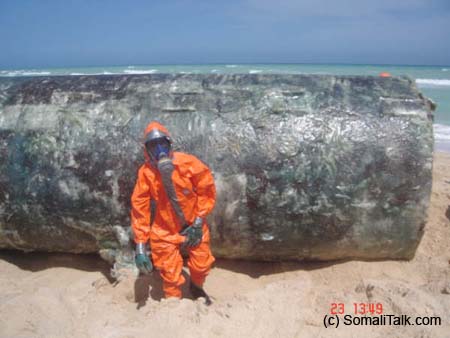An investigation into the murder of Ilaria Alpi who was investigating arms trafficking and the illegal disposal of toxic waste off the coasts of Somalia. (Report and Photos below the video)
Somalia’s secret dumps of toxic waste washed ashore by tsunami
Source:Timesonline
From Jonathan Clayton in Johannesburg
THE huge waves which battered northern Somalia after the tsunami in December are believed to have stirred up tonnes of nuclear and toxic waste illegally dumped in the war-racked country during the early 1990s.
Apart from killing about 300 people and destroying thousands of homes, the waves broke up rusting barrels and other containers and hazardous waste dumped along the long, remote shoreline, a spokesman for the United Nations Environment Programme (Unep) said.
“Initial reports indicate that the tsunami waves broke open containers full of toxic waste and scattered the contents. We are talking about everything from medical waste to chemical waste products,” Nick Nuttal, the Unep spokesman, told The Times.
“We know this material is on the land and is now being blown around and possibly carried to villages. What we do not know is the full extent of the problem.”
Mr Nuttall said that a UN assessment mission that recently returned from the lawless African country, which has had no government since 1991, reported that several Somalis in the northern areas were ill with diseases consistent with radiation sickness. “We need more information. We need to find out what has been going on there, but there is real cause for concern,” he added. “We now need to urgently send in a multi-agency expert mission, led by Unep, for a full investigation.”
An initial UN report says that many people in the areas around the northeastern towns of Hobbio and Benadir, on the Indian Ocean coast, are suffering from far higher than normal cases of respiratory infections, mouth ulcers and bleeding, abdominal haemorrhages and unusual skin infections.
“The current situation along the Somali coastline poses a very serious environmental hazard not only in Somalia but also in the eastern Africa sub-region,” the report says. Toxic waste was first dumped in Somalia in the late 1980s, but accelerated sharply during the civil war which followed the 1991 overthrow of the late dictator Mohamed Siad Barre.
Local warlords, many of them former ministers in Siad Barre’s last government, received large payments from Swiss and Italian firms for access to their respective fiefdoms.
Most of the waste was simply dumped on remote beaches in containers and leaking disposable barrels.
Somali sources close to the trade say that the dumped materials included radioactive uranium, lead, cadmium, mercury and industrial, hospital, chemical and various other toxic wastes. In 1992, Unep said that European firms were involved in the trade, but because of the high level of insecurity in the country there were never any accurate assessments of the extent of the problem.
In 1997 and 1998, the Italian newspaper Famiglia Cristiana, which jointly investigated the allegations with the Italian branch of Greenpeace, published a series of articles detailing the extent of illegal dumping by a Swiss firm, Achair Partners, and an Italian waste broker, Progresso.
The European Green Party followed up the revelations by presenting to the press and the European Parliament in Strasbourg copies of contracts signed by the two companies and representatives of the then “President” — Ali Mahdi Mohamed — to accept 10 million tonnes of toxic waste in exchange for $80 million (then about £60 million).
Abdullahi Elmi Mohamed, a Somali academic studying in Sweden, told The Times that this worked out at “approximately $8 per tonne, while in Europe the cost for disposal and treatment of toxic waste material could go up to $1,000 per tonne”.
Mr Ali Mahdi, who then controlled north Mogadishu and who worked closely with the UN during its disastrous 1992-95 humanitarian mission to the country, has always refused to discuss the issue even though an Italian parliamentary report subsequently confirmed many of the allegations.
Photos
|
|
|
|
|
|
|
|
|
|
|
|
|
|
|
|
|
|
|
|
SOURCE: SOMALIA MONITOR/SOMALIA TALK




